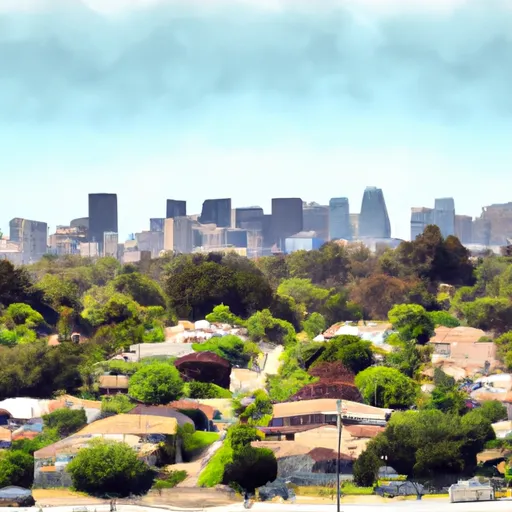-
 Snoflo Premium
Snoflo Premium
Get unlimited access to all our content
With no Ad interruptions! - Start Your Free Trial Login with existing account
La-Mesa
Eden Index
Climate
8.9
•
Recreation
6.2
•
Community
3.4
•
Safeguard
6.6/10

La Mesa is a charming city located in San Diego County, California. It boasts a Mediterranean climate characterized by warm, dry summers and mild, wet winters. Summers in La Mesa are typically sunny and hot, with temperatures averaging in the mid-80s°F (30°C), while winters are pleasant and mild, with temperatures averaging in the mid-60s°F (18°C). The city receives most of its precipitation between November and March, with an annual average of around 12 inches (305 mm).
La Mesa is situated near the headwaters of the San Diego River, which flows through the city. The river supports diverse hydrology constituents, playing a crucial role in maintaining the area's ecological balance. Outdoor enthusiasts can explore the river and its surrounding areas, which provide numerous recreational opportunities. Hiking and biking trails, such as the Mission Trails Regional Park and Lake Murray, offer scenic views and opportunities for outdoor activities. Residents and visitors can also enjoy boating, fishing, and picnicking at Lake Murray. With its pleasant climate and proximity to nature, La Mesa provides a haven for outdoor enthusiasts seeking adventure and relaxation.
What is the Eden Index?
The Snoflo Eden Index serves as a comprehensive rating system for regions, evaluating their desirability through a holistic assessment of climate health, outdoor recreation opportunities, and natural disaster risk, acknowledging the profound impact of these factors on livability and well-being.
Climate Health Indicator (CHI): 8.9
La-Mesa receives approximately
338mm of rain per year,
with humidity levels near 74%
and air temperatures averaging around
18°C.
La-Mesa has a plant hardyness factor of
10, meaning
plants and agriculture in this region tend to thrive here all year round.
By considering the ideal temperature range, reliable water supplies, clean air, and stable seasonal rain or snowpacks, the Climate Health Indicator (CHI) underscores the significance of a healthy climate as the foundation for quality living.
A healthy climate is paramount for ensuring a high quality of life and livability in a region, fostering both physical well-being and environmental harmony. This can be characterized by ideal temperatures, reliable access to water supplies, clean air, and consistent seasonal rain or snowpacks.
Weather Forecast
Streamflow Conditions
Laguna-San Diego Coastal
Area Rivers
Laguna-San Diego Coastal
Snowpack Depths
Laguna-San Diego Coastal
Reservoir Storage Capacity
Laguna-San Diego Coastal
Groundwater Levels
Recreational Opportunity Index (ROI): 6.2
The Recreational Opportunity Index (ROI) recognizes the value of outdoor recreational options, such as parks, hiking trails, camping sites, and fishing spots, while acknowledging that climate plays a pivotal role in ensuring the comfort and consistency of these experiences.
Access to outdoor recreational opportunities, encompassing activities such as parks, hiking, camping, and fishing, is crucial for overall well-being, and the climate plays a pivotal role in enabling and enhancing these experiences, ensuring that individuals can engage in nature-based activities comfortably and consistently.
Camping Areas
| Campground | Campsites | Reservations | Toilets | Showers | Elevation |
|---|---|---|---|---|---|
| Dos Picos | 68 | 1,505 ft | |||
| Kumeyaay Lake Campground - Mission Trails Park | 46 | 626 ft | |||
| Sweetwater Summit | 112 | 280 ft | |||
| Dixon Lake | 45 | 1,062 ft | |||
| Admiral Baker Military - San Diego NS | None | 79 ft | |||
| Fiddlers Cove RV Military - Coronado NB | None | 8 ft | |||
| Lake Jennings | None | 706 ft | |||
| Santee Lakes Regional Park | 300 | 323 ft | |||
| Silver Strand State Beach Dispersed | 140 | 12 ft |
Catastrophe Safeguard Index (CSI):
The Catastrophe Safeguard Index (CSI) recognizes that natural disaster risk, encompassing floods, fires, hurricanes, and tornadoes, can drastically affect safety and the overall appeal of an area.
The level of natural disaster risk in a region significantly affects safety and the overall livability, with climate change amplifying these risks by potentially increasing the frequency and intensity of events like floods, fires, hurricanes, and tornadoes, thereby posing substantial challenges to community resilience and well-being.
Community Resilience Indicator (CRI): 3.4
The Community Resilience Indicator (CRI) recognizes that education, healthcare, and socioeconomics are crucial to the well-being of a region. The CRI acknowledges the profound impact of these elements on residents' overall quality of life. By evaluating educational resources, healthcare accessibility, and economic inclusivity, the index captures the essential aspects that contribute to a thriving community, fostering resident satisfaction, equity, and social cohesion.

